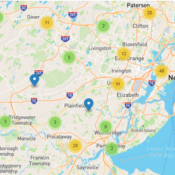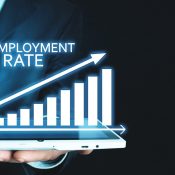INTERACTIVE: 2020 Economic Review Statistical Update
ISSUE 2 | March 2022
Previously released in April 2021, Focus NJ’s 2020 Economic Review: An Annual Review of New Jersey’s Economy has been updated to include revised figures which were preliminary at the time Issue 1 was released, highlight new measures of the economy’s overall health and wellbeing, and to enhance how readers interact with our data.
By converting previously static images into interactive visualizations, readers can now identify specific data points included in our analysis and create their own comparisons of how various residents and industries experienced the uncertainty of 2020.
A few notes on using the interactive data visualizations below:
- Due to the size and point-and-click nature of the visualizations, they are best interacted with using a desktop/laptop computer, or large mobile device.
- For graphs which utilize a color-based legend, selecting an item from the legend will highlight those entries on the graph and apply data labels.
- Graphs which include drop-down filters must be built around at least one measurement – even when all entries are deselected, one entry will remain.
*All figures are current as of Feb. 28, 2022.
INTRODUCTION
2020 was a year unlike any other experienced during our lifetime. The novel coronavirus pandemic caused havoc on New Jersey’s public health and economy. The pandemic caused government-mandated, nonessential business closures and stay-at-home orders that were in effect from mid-March to mid-June 2020 in the Garden State, with many businesses continuing to operate at restricted capacity through year end.
➢ This resulted in record high unemployment rates and record contraction in GDP.
➢ Small businesses were devastated and many were forced to shut their doors, either temporarily or permanently.
➢ The pandemic disproportionately impacted minority workers and workers of color.
➢ In total, over 1.9 million people filed unemployment claims and received more than $20 billion in unemployment benefits.
➢ Personal income increased despite record high unemployment, due to state unemployment benefits, extended benefits, and federal stimulus monies.
The goal of this research is to provide readers with a detailed review of key statistics on New Jersey’s economic activity, otherwise known as economic indicators. These indicators help to judge the overall health of an economy. New to this update are measurements which look more closely at how different demographic groups were impacted throughout 2020 (i.e. households, gender, race, education level).
EMPLOYMENT
Over the course of 2020, New Jersey’s civilian labor force fell from approximately 4.6 million to 4.4 million. The state’s labor force participation rate fell from 64.6% in March to 61.9% in December.
The number of residents employed in New Jersey fell from 4.4 million to 4.04 million over the course of 2020. The employment-to-population ratio, a measure of the number of employed state residents as a share of the total population, also fell from 62.2 to 57.1.
As of December 2020, the Trade, Transportation and Utilities industry was the largest employer industry in the state, providing 848,100 jobs. From March to December, every major industry in New Jersey suffered employment losses.
UNEMPLOYMENT
Unemployment in New Jersey hit record highs in the second quarter of 2020 when the onset of the COVID-19 pandemic wreaked havoc throughout the economy. Although the number of unemployed fell significantly over the course of the year, more than 300,000 workers remained unemployed at the end of the year.
Unemployment was not uniform across all residents, and minority populations were impacted disproportionately. At an annualized rate, Black women in New Jersey faced the highest unemployment (14.6%) of all groups in 2020.
Workers with lower educational achievement were also disproportionately impacted throughout the year. From 2019 to 2020, the unemployment rate among workers with a high school degree and no college increased from 3.5% to 11.6%. Conversely, unemployment among those with a bachelor’s degree or higher increased from 2.4% to just 5.2%.
INCOME
Despite record high unemployment, per capita personal income and per capita disposable income both increased in New Jersey by nearly $4,000 in 2020.
Median household income, a measure of all income derived by members of a household regardless of familial status, also increased in 2020, jumping from $85,751 to $105,788.
Although income increased in 2020, the number of New Jersey residents under 64 years of age living below the poverty line increased by 33,521.
CONSUMER SPENDING
After cratering amidst the pandemic’s onset, consumer spending rebounded, ending 2.04% higher on Dec. 31, 2020, relative to January 2020.
GDP
New Jersey’s GDP experienced record contraction in Q2 2020 followed by a quick rebound in Q3 . The decline in Q2 resulted in New Jersey’s percent of U.S. GDP dropping to 2.9%. This percentage rebounded briefly in Q3 before dropping again to 2.9% in Q4.
Q2’s contraction represented a deceleration of 38.9% from the preceding quarter. The rapid recovery into Q3 then represented a 39.5% expansion. New Jersey exceeded the nation in both its initial contraction and the growth rate which followed.
In 2020, New Jersey’s largest industry as a percent of total GDP was finance, insurance, real estate, and leasing. According to the U.S. Bureau of Economic Analysis, “This industry accounted for 22% of New Jersey GDP and experienced a 1.6% real decline” compared to 2019.
SOURCES
Opportunity Insights Economic Tracker (January 2021). Spending: Consumer Spending. Retrieved from https://tracktherecovery.org/
U.S. Bureau of Economic Analysis (January 2021). State Level Personal Income. Retrieved from https://www.bea.gov/data/income-saving/personal-income-by-state
U.S. Bureau of Economic Analysis. (March 2021) Gross Domestic Product by State, 4th Quarter 2020 and Annual 2020 (Preliminary). Retrieved from https://www.bea.gov/data/gdp/gdp-state
U.S. Bureau of Economic Analysis (January 2021). Per Capita Annual and Disposable Income. Retrieved from https://apps.bea.gov/itable/iTable.cfm?ReqID=70&step=1&acrdn=1
U.S. Bureau of Labor Statistics. (January 2021). Labor Force Data Series. New York-New Jersey Information Office. Retrieved from https://data.bls.gov/pdq/SurveyOutputServlet
U.S. Bureau of Labor Statistics. (January 2021). Employment by Industry. Retrieved from https://www.bls.gov/regions/new-york-new-jersey/new_jersey.htm
U.S. Bureau of Labor Statistics. (January 2021). Unemployment by Race/Education. Retrieved from https://www.bls.gov/opub/geographic-profile/home.htm
U.S Census Bureau. (January 2021). Median Household Income. Retrieved from https://data.census.gov/cedsci/table?t=Earnings%20%28Individuals%29&g=0400000US34&y=2018&tid=ACSST1Y2018.S1901
U.S Census Bureau. (January 2021). Poverty Status. Retrieved from Explore Census Data
Next Update: 2021 Economic Review (Spring 2022)




